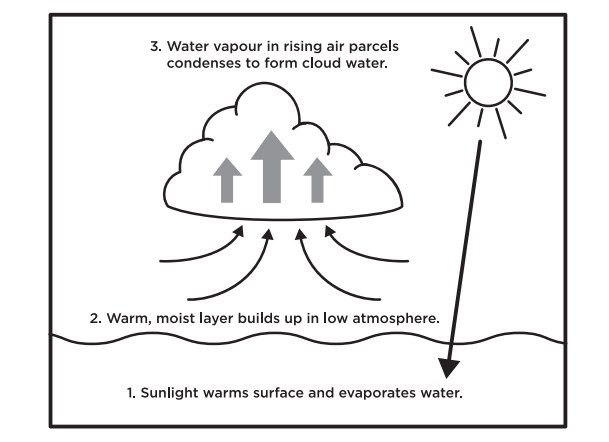Objectives
-
Describe and illustrate the water cycle and associate parts of the cycle with weather conditions.
-
Observe and describe changes to the properties of water when it is heated or cooled and associate these changes with weather conditions.
Materials
Key Questions
-
What is a cloud made of?
-
In what conditions does a cloud form?
-
What happens when we pump air into the bottle?
-
What is happening to the molecules?
-
What happens to the gas molecules when we open up the bottle?
-
How does the cloud in the bottle differ from clouds in the sky?
What To Do
Preparation
- Create the plug that will allow you to attach a bicycle pump to the pop bottle, by first cutting the cork to about half its length.
- Push the ball inflating needle through the cork, so that the end of the needle pokes out of the end.
- Insert a toothpick into the cork sideways, to create a barrier that stops the cork from being pushed inside the bottle.

Demonstration
- Pour about 60ml of rubbing alcohol into an empty bottle and seal it with the prepared stopper.
- Tilt and shake the bottle so that the alcohol coats the entire inside.
- Attach the bike pump and add four pumps of air.

- Quickly remove the stopper and watch the cloud form.
- To repeat the effect, reattach the stopper and add more air
Safety Tips
- Use only a small amount of rubbing alcohol. Pour back the excess.
- Everyone near the demonstration must wear goggles. Over pressurization of the bottle may cause it to rupture or explode.
- Release stopper quickly—be sure to aim the top of the bottle away from people as some liquid may spray out.
Explanation
This demonstration shows how water in the atmosphere can be made visible by changes in pressure. Pumping air inside the bottle compresses the molecules and heats them up, causing them to evaporate into gas.
When you pull the cork out, you lower the air pressure letting the gas molecules expand and cool. Warmer air rushes out and cooler air rushes in. As it cools the gaseous vapour condenses into liquid particles forming tiny suspended droplets. A “cloud” or fog forms.
Although real clouds are formed from water droplets we use rubbing alcohol in this demonstration because it evaporates more readily than water and creates a more dramatic example of what happens in the water cycle.
Extensions
-
Describe the three main types of clouds and learn how they form. (Cumulus, Stratus and Cirrus) Explore the sub-groups of these cloud types.
-
Make a cloud journal, sketching and labeling the clouds they observe over the course of the day or days.
Other Resources
Science World | YouTube | How to Make a Cloud in a Bottle
University Corporation for Atmospheric Research | Center for Science Education | Web Weather for Kids | Cloud Types




